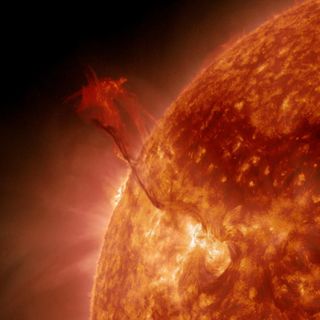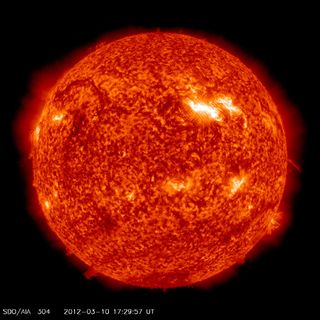Sun Grows Super-Hot 'Dragon Tail' in Amazing NASA Video

A NASA spacecraft studying the sun has recorded amazing video of a giant plume of super-hot plasma erupting from the star's surface, only to crash back down hours later.
The solar plasma eruption, which NASA scientists nicknamed a "Dragon Tail," rose up from the sun's surface today (Jan. 31) and was spotted by the agency's Solar Dynamics Observatory, a powerful spacecraft that constantly records the sun's weather in different wavelengths of light.
A video of the Dragon Tail solar eruption shows a tendril of solar plasma, which scientists call a "filament," extending across the northeastern face of the sun over the course of four hours. Near the end of the event, the filament begins to break apart.
"Some of the plasma was released into space but not all could escape the gravitational pull of the sun," SDO mission officials explained in a video description. "It's not surprising that plasma should fall back to the sun. After all, the sun's gravity is powerful. "
Filaments are plasma formations on the sun sculpted by the star's intense magnetic field, with one end anchored to the sun's surface. The other end can extend through the sun's outer atmosphere, called the corona, hundreds of thousands of miles into space.

Filament structures typically last about a single day, though stable ones can exist for months at a time, SDO officials explained. The plasma in filaments consists of super-hot helium and hydrogen that is electrically charged, they added.
NASA's Solar Dynamics Observatory is one of several spacecraft constantly monitoring the sun for signs of solar flares, eruptions and other space weather events. The sun is currently in an active phase of its 11-year solar weather cycle and is expected to reach its peak activity period in 2013. The current sun weather cycle is known as Solar Cycle 24.
Get the Space.com Newsletter
Breaking space news, the latest updates on rocket launches, skywatching events and more!

You can follow SPACE.com Managing Editor Tariq Malik on Twitter @tariqjmalik. Follow SPACE.com for the latest in space science and exploration news on Twitter @Spacedotcom and on Facebook.
Join our Space Forums to keep talking space on the latest missions, night sky and more! And if you have a news tip, correction or comment, let us know at: community@space.com.

Tariq is the Editor-in-Chief of Space.com and joined the team in 2001, first as an intern and staff writer, and later as an editor. He covers human spaceflight, exploration and space science, as well as skywatching and entertainment. He became Space.com's Managing Editor in 2009 and Editor-in-Chief in 2019. Before joining Space.com, Tariq was a staff reporter for The Los Angeles Times covering education and city beats in La Habra, Fullerton and Huntington Beach. In October 2022, Tariq received the Harry Kolcum Award for excellence in space reporting from the National Space Club Florida Committee. He is also an Eagle Scout (yes, he has the Space Exploration merit badge) and went to Space Camp four times as a kid and a fifth time as an adult. He has journalism degrees from the University of Southern California and New York University. You can find Tariq at Space.com and as the co-host to the This Week In Space podcast with space historian Rod Pyle on the TWiT network. To see his latest project, you can follow Tariq on Twitter @tariqjmalik.
